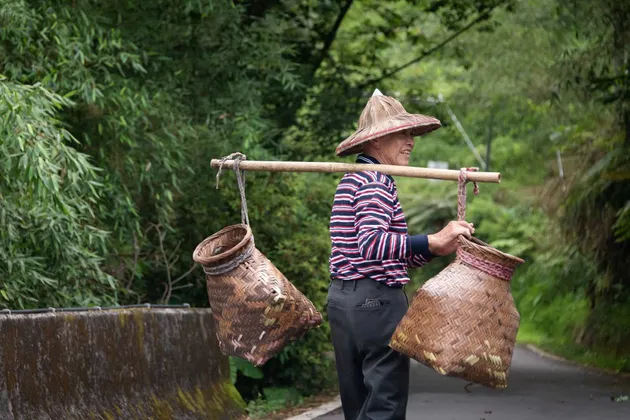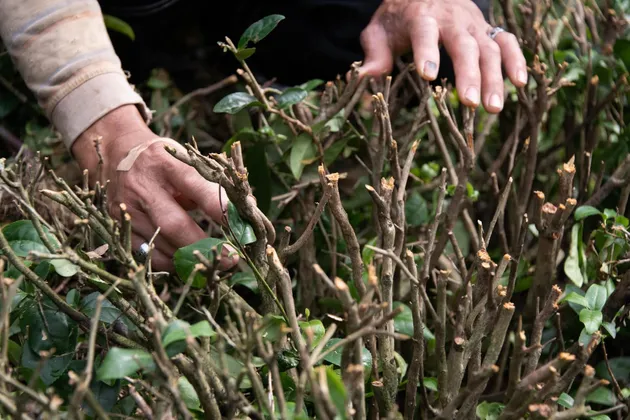Taiwan’s tea growers on the defensive against climate change

Source:Ming-Tang Huang
Tea farmers in northern Taiwan are struggling with the consequences of climate change that are stunting the growth of their tea trees. One tea champion has even fallen prey to this unforgiving foe. What are they doing to cope?
Views
Taiwan’s tea growers on the defensive against climate change
By Wen Hao WangFrom CommonWealth Magazine (vol. 750 )
A small tea-growing village in Shiding on the winding mountainous highway connecting New Taipei to Taiwan’s east coast is known for the majestic Feitsui Reservoir. Yet the mesmerizing scenery belies the battle nearby tea farmers are waging to cope with the threat of climate change.
The area is the biggest producer in Taiwan of Wenshan Pouchong tea, a top-flight Taiwanese tea that has a tangy orchid aroma.
Yong’an Village in the Shiding area was home in the 1960s to the first model tea factory in Taiwan to use semi-automatic tea-making technology. Twenty years later, the Feitsui Reservoir submerged the factory and large swathes of tea plantations, in essence consigning much of the Shiding tea industry to a watery grave. Only a small number of tea farmers strived to keep alive the tea plantations and tea-making facilities that survived the reservoir’s reach.
 (Source: Ming-Tang Huang)
(Source: Ming-Tang Huang)
Now, they face another threat to their survival: climate change. It is rather ironic that the Feitsui Reservoir has saved Greater Taipei residents from water shortages, yet nearby Yong’an tea farmers are seeing large areas of tea trees wither due to drought.
Sacrificed to the reservoir, now hit by climate change
“When you grow tea, you’re at the mercy of nature to survive, but nature is becoming increasingly elusive,” says 57-year-old local farmer Lin Wen-chang (林文章). In 2020, Lin won first prize in the Shiding Spring Wenshan Pouchong tea competition, but he could not have anticipated the drought that hit most of Taiwan in the first half of 2021, causing serious damage to his tea farm.
“Climate change is affecting the growth of tea trees, kind of like the frog in warm water slowly being boiled to death before realizing it,” said Tsai Hsien-tsung (蔡憲宗), the head of the government-run Tea Research and Extension Station’s Tea Agronomy Section.
He explained that tea trees grow best in temperatures between 18 and 25 degrees Celsius. When temperatures exceed 30 degrees, new shoots grow more slowly or stop growing altogether, and above 35 degrees they tend to wither and shed leaves. Above 45 degrees, tea trees begin to die.
As for rainfall, tea trees need at least 100 millimeters of rainfall per month during the growing season, and anything below 50 millimeters without other sources of irrigation will lead to dramatic falls in harvests, according to Tsai.
The station said temperatures in Taiwan have risen 1.6 degrees over the past 100 years, averaging 24.62 degrees in 2020, which is close to the upper boundary of the optimal tea-growing temperature range.
Just as concerning to farmers, the number of high-temperature days during the summer has repeatedly hit new highs in recent years, often exceeding optimal tea-growing temperatures. Global warming has also led to more polarized wet and dry seasons. The gap in rainfall between wet and dry years has widened, with extreme rainfall more intense but lower-than-usual rainfall during the typhoon and plum rain seasons.
This is all bad news for tea trees. As perennial crops that do not need to be replanted every growing season, tea trees are particularly vulnerable to big changes in rainfall from year to year, explaining why climate change is squeezing the number of areas in Taiwan where tea plantations are feasible.
The Chin Shin oolong tea variety (also known as Green tip oolong), which is planted on about 60 percent of the acreage in Taiwan devoted to tea, is best suited to producing Wenshan Pouchong tea and fetches a price about 20-30 percent higher than other varieties. But even more than for other varieties, climate change is its Achilles’ heel.
Tsai said Chin Shin oolong grows best in a cool environment and is especially sensitive to changes in temperature and humidity. When exposed to drought, the plants inevitably suffer from a bacterial disease called shoot blight that sends harvests and the quality of the tea plummeting.
 (Source: Ming-Tang Huang)
(Source: Ming-Tang Huang)
Given Taiwan’s rising temperatures, Chin Shin oolong needs to be grown at a higher altitude than in the past – estimated now at about 800 meters and above – to be viable.
That means that growing areas at altitudes of between 200 and 650 meters supplying tea leaves for Wenshan Pouchong tea in northern Taiwan and sources of Dong Ding oolong tea on Dong Ding Mountain in Nantou at 750 meters in altitude may no longer be viable for growing Chin Shin oolong trees.
The variety’s future in Yong’an at only 200 meters in altitude is particularly bleak, and not even a champion farmer like Lin could stave off the inevitable. After his Chin Shin oolong trees were wiped out by a water shortage and high temperatures, he was forced to plant other tea varieties.
The Tea Research and Extension Station is fighting back by encouraging farmers to plant tea varieties that are more resistant to disease and drought and trying to breed heat- and drought-resistant Chin Shin oolong varieties. It has also set up an Internet of Things monitoring system, introducing smart agricultural technology to help farmers adapt to changing conditions.
Learning ‘smart agriculture’ at 80
The center has established 23 micro weather stations in tea growing areas around the country to collect and analyze weather information and set up an information platform that provides weather alerts, tea tree growth forecasts and tea-growing and production management suggestions. The information can be accessed via mobile phone.
 The center brought in new technology aims to improve the management efficiency, reduce the harm (Source: Ming-Tang Huang)
The center brought in new technology aims to improve the management efficiency, reduce the harm (Source: Ming-Tang Huang)
This data can give farmers guidance on the approaches they should use based on their local conditions to manage their plantations more efficiently. Automatic irrigation systems can be controlled based on the data, for example, to control the amounts of water delivered to the tea trees, reducing the number of trees that die during dry seasons.
Farmers from their 30s to their 80s have been attending classes to learn about the new technology. Lin said experienced tea farmers tend to rely on their instincts and experience to plant and produce tea, making few concessions to hard data other than looking at the daily weather report. Now, however, they are discovering that with more precise data, they can continually optimize their planting and production processes.
Six local tea farmers in Yong’an Village have adopted another approach in a bid to help the area’s tea industry regain some of its past glory. They have transitioned this year to eco-friendly cultivation, forgoing chemical fertilizers and pesticides.
For many farmers, going organic carries the risk of smaller harvests, which is why a smart agriculture system to accurately control the microclimate and soil fertility can pay big dividends.
The drought of 2021 reduced water levels at Feitsui Reservoir enough that remnants of the long-submerged Yong’an model tea plant resurfaced, stirring up memories of this forgotten chapter of local history. But it also delivered a clear warning: The time has come for Taiwan’s tea sector to reinvent itself once again.
Have you read?
- Climate change throws Taiwan’s mackerel fishing into crisis
- Taiwan’s first climate refugees
- How Taiwan’s expanding semiconductor industry deals with water shortages
Translated by
Luke Sabatier
Edited by TC Lin
Uploaded by Ian Huang






